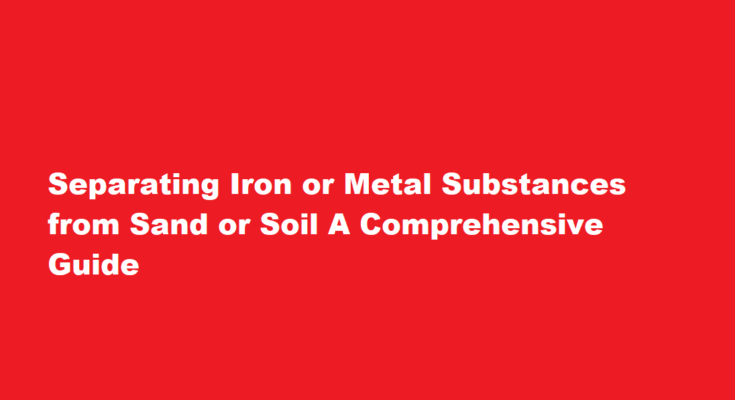Introduction
The need to separate iron or metal substances from sand or soil arises in various industrial, environmental, and scientific applications. Whether you are cleaning up a polluted site, recovering valuable metals from soil, or conducting a school experiment, knowing how to effectively separate these materials is crucial. This article provides a unique and informative guide on the methods and techniques for separating iron or metal substances from sand or soil.
Why Separate Iron or Metal from Sand or Soil?
Before delving into the methods, it’s essential to understand why we need to separate iron or metal from sand or soil. The primary reasons include environmental remediation, resource recovery, and scientific analysis.
Environmental Remediation
Polluted sites often contain heavy metals, such as iron, that pose significant environmental hazards. Separating these metals from the soil is essential for cleaning up contaminated areas and preventing further damage to ecosystems.
Resource Recovery
In the field of mining and metallurgy, separating valuable metals from ore-bearing soils is crucial for extracting precious resources like iron, copper, or gold.
Scientific Analysis
Researchers and scientists may need to separate metals from soil or sand to study their properties or conduct experiments. This requires precise techniques to obtain pure metal samples.
Methods for Separating Iron or Metal from Sand or Soil
Magnetic Separation
Magnetic separation is one of the most effective methods for separating iron or metal substances from sand or soil. This method relies on the magnetic properties of iron and some other metals. Here’s how it works
- Place the mixture of sand, soil, and metal on a flat surface.
- Pass a strong magnet over the mixture. Iron and magnetic metals will be attracted to the magnet and separated from the non-magnetic sand or soil.
Magnetic separation is quick, efficient, and non-destructive, making it suitable for a wide range of applications.
Gravity Separation
Gravity separation is another widely used method for separating materials based on their density differences. This method is particularly useful for separating heavy metals like lead or iron from lighter materials such as sand or soil
- Create a slurry by mixing the sand or soil with water, allowing the heavy metals to sink while the lighter materials stay suspended.
- After some time, carefully decant or scoop off the top layer, which should be relatively free from heavy metals.
Gravity separation is cost-effective and suitable for large-scale operations.
Electromagnetic Separation
Electromagnetic separation is a more advanced technique primarily used in industrial settings. It relies on electromagnetic fields to separate metallic substances from non-metals. Here’s how it works
- The mixture is passed through a conveyor belt equipped with powerful electromagnets.
- As the mixture moves along the conveyor, the electromagnetic field attracts and separates the metal substances from the sand or soil.
This method is highly efficient but requires specialized equipment.
Chemical Extraction
In some cases, chemical extraction can be used to separate metals from soil or sand. This method is more complex and is typically employed for laboratory analysis or when other methods are ineffective
- A chemical solution is added to the mixture, which reacts with the metal to form a soluble compound.
- The soluble compound can then be separated from the remaining sand or soil, often through filtration or centrifugation.
- The metal can later be recovered from the soluble compound through precipitation or other chemical processes.
Chemical extraction requires expertise and careful handling of chemicals.
Frequently Asked Questions
How will you separate iron particles from the sand or soil?
The magnetic separation is a process in which magnetically susceptible material is extracted from a mixture using magnetic force. This is the best way to separate the mixture of sand and iron filings as iron is attracted by magnet.
How is iron extracted from sand?
The sand is pumped as slurry to the floating concentrator building where lighter material is removed before the denser fraction passes through magnetic separators. The concentrated iron slurry is then pumped up to five km where it awaits the arrival of the bulk carrier ship.
Conclusion
Separating iron or metal substances from sand or soil is a crucial process with various applications in environmental cleanup, resource recovery, and scientific research. Depending on your specific needs and resources, you can choose from a range of methods, including magnetic separation, gravity separation, electromagnetic separation, or chemical extraction. Each method has its advantages and limitations, so selecting the appropriate technique is essential for achieving successful separation. By following the guidelines outlined in this article, you can make informed decisions and contribute to cleaner environments, efficient resource utilization, and valuable scientific discoveries.
Read Also : Separating Iron from Corn Flakes A Unique Solution



